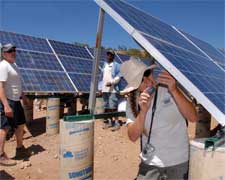College spends $5 million to save $200,000

LONG-TERM INVESTMENT: Santa Fe Community College has spent $5 million from a taxpayer-approved bond to build a solar array. Is it a good investment? Photo from SFCC website.
By Rob Nikolewski │ New Mexico Watchdog
SANTA FE, N.M. — Santa Fe Community College has just unveiled a solar array that, it says, will save the college at least $200,000 a year on its utility bills.
But the array, funded by taxpayers in a 2010 bond election, will cost $5 million.
You don’t have to be a math major at the college to figure out it would take 25 years of $200,000 cost savings per year to reach the $5 million mark for the project to just break even.
So is the solar array a good deal?
SFCC interim president Randy Grissom thinks so.
First off, Grissom told New Mexico Watchdog the college expects to save more than $200,000 a year on utility bills.
“We took a really conservative approach in doing our analysis,” Grissom said. “We anticipate it will be between $200,000 to $300,000 (a year in savings).”
But even at $300,000 a year, it would take almost 17 years to break even, right?
“We did a ‘net present value’ analysis of the project,” Grissom said, adding that the analysis showed “a gain of $1.5 million” over the life of the solar array, which, Grissom says, is guaranteed to last 25 years.
But given some of the solar industry’s problems in recent years, taxpayers have reason to be skeptical.
For example, in summer 2012, after getting $16 million in grants from the state, Schott Solar shut down its manufacturing plant in south Albuquerque and laid off 250 workers. New Mexico taxpayers had to eat more than $12 million because the administration of then-Gov. Bill Richardson did not include any clawback provisions in the deal with Schott.
Taxpayers also got stuck losing millions in 2009, when Advent Solar went belly-up, despite receiving nearly $17 million through the State Investment Council and its private equity arm.
Nationally, the Brookings Institution reported the U.S. government has allocated more than $150 billion to green initiatives since 2009, and the International Energy Agency estimates nations across the globe have made more than $2 trillion in renewable energy investments in the past 20 years.
“There’s too little to show from the investments, however,” Wall Street Journal reporter Gregory Zuckerman wrote in his book, “The Frackers,” about the oil and gas industry in the U.S.
“Cars don’t run on waste, and wind and solar aren’t yet ready to power the world,” Zuckerman said. “Instead, a group of frackers, relying on market cues rather than government direction, achieved dramatic advances by focusing on fossil fuels, of all things. It’s a stark reminder that breakthroughs in the business world usually are achieved through incremental advances, often in the face of deep skepticism, rather than government-inspired eureka moments.”
But SFCC’s Grissom, who said, “we worked on projects like this all the time” when he used to be a vice-president of a technology business at General Electric 14 years ago, said he’s confident of a positive return on investment in the $5 million solar array.
“We went through the whole process to make sure this was a good project for the college to do,” Grissom said. “Not only is it good for the college, but for the taxpayers.”
Grissom said analysis for the project included renewable energy credits the college will rack up from PNM, the state’s largest electric utility, and conservatively predicted modest 1 percent annual increases in energy rates. With energy increases usually higher than that, SFCC claims the project will be a financial winner.
In addition, Grissom said the solar array has an important educational element for SFCC students, who can earn certificates as solar installers, designers and sales people.
“This will save money the over the long-term, and that money can go back to the students, rather than paying utility bills,” Grissom said.
Earlier this year, the SFCC Governing Board came under fire for spending $500,000 in taxpayer money to oust former president Ana “Cha” Guzmán. Grissom has been named the school’s interim president and has expressed his desire to fill the job permanently.
Want to hear more? Rob Nickolewski discuses the costs and benefits http://watchdog.org/wp-content/blogs.dir/1/files/2014/05/Rob-Nickolewski-talks-solar-panels.mp3
Contact Rob Nikolewski at rnikolewski@watchdog.org and follow him on Twitter @robnikolewski







